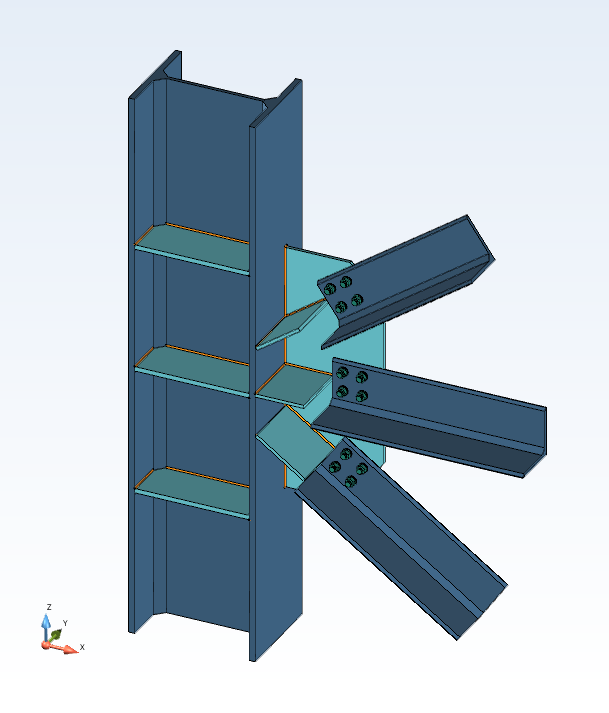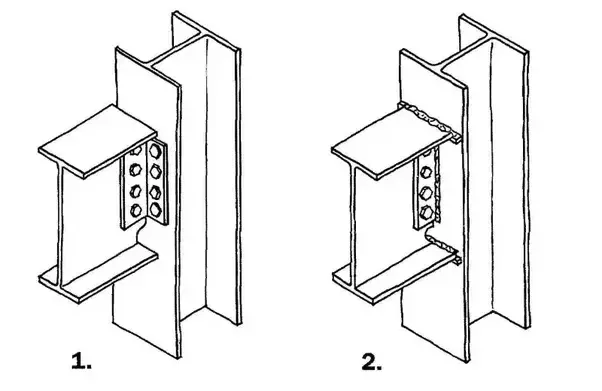Steel Structure Joint Connection Types and its Uses
Steel connections are mainly used for connecting structural members made up of steel. The connection allows force and moment to be transferred from steel structure to column and finally to the ground supports. The members are connected to each other by different fittings and elements like plates, nut-bolts, rivets, welding for the ease of assembly and disassembly during the construction process.
The connection can be classified based on different configurations. They are divided into following types.
1. Based on method used for connecting two members :
a. Riveted connection
The riveted connection is achieved by riveting plate or angle like component to both connecting members. A rivet is made up of a round ductile steel bar which is called a ‘shank’ and with a head at one end. It is made up of mild steel or high tensile steel. They are punched against plates to make the end round after inserting in desired holes.

Image Source: Steel rivets 1080P, 2K, 4K, 5K HD wallpapers free download
❖ Advantages of riveted connection:
● More reliable
● Easily used for non-steel members
● The members joined by rivets do not have any thermal after effect
● Inspection and error finding in connection are easy and cheap
● After dismantling, riveted members has less damage than welded members
❖ Disadvantages of riveted connection
● Due to holes in connecting members they become weak
● Cost for riveted joints are generally more
● Labor cost is high
● Riveted joints have more weights then their welded counterparts
● Stress concentration is more near holes
b. Bolted connection
The bolted connections are achieved by bolting structural members with each other with the help of nut-bolts and supporting plates. Nut bolts are available in standard size and holes are made in each member accordingly. Then supporting plates and bolts are inserted into the hole and tightened by nuts with the help of wrenches.

Image Source: How To Design A Bolted Steel Connection Between A Tee And Beam Flange Subjected To Prying Force
❖ Advantages of bolted connection:
● The process of erection of structure can be made much faster.
● Connections do not involve any noise.
● Skilled labors are not required and less manpower required
● Immediate reuse of structural members are possible
● Less working area is required
● Re-arrangement of structural members are very easy
❖ Disadvantages of bolted connection:
● Material Cost is very high.
● Nut and bolts get loose if structure is subjected to vibration and shock.
● Strength of structural members and connecting plates are reduced due to holes.
● High stress concentration occurs near to holes.
c. Welded connection
The welded connection is achieved by welding structural members with or without the help of secondary plates or angles. Process of welding connection is mainly done on site for large structural construction.

Image Source: Bolts vs Welds vs Rivets for Steel Connections
❖ Advantages of welded connection:
● Force transfer is more direct
● Connecting members are easy to make
● On site work is possible
● Connection are more rigid
● Member strength is not reduced due to the holes
● No noise is produced during the welding process.
❖ Disadvantages of welded connection
● Skilled manpower is required for welding
● Welding equipment and filler materials are required
● Large working space is required
● Damage of members during disassembling
● After welding, members have thermal after effect and are subjected to different stress.
● Welded joints are more brittle and they also have other defects like air packets, slag inclusions and incomplete penetration.
d. Combination Connection
The combination connection is achieved by combining any of the above mentioned connection methods. This type of connection is used nowadays in the construction process.

Image Source: Steel Connection Designer - Gusset
e. Pinned connection
Pinned connections are used for transmission of only axial forces not bending moment in between two members. They are used for truss building and other mechanisms where pinned connection is required for movement.

2. Based on capacity for transmitting different forces
a. Shear Connection
When connection between two members can transfer shear or axial force effectively but not moment then this type of connection is called shear connection. It is widely used for beams which are supported at both ends. The shear connection is achieved by using different connecting methods like riveting, bolting welding etc. as stated above.

Image Source: What is difference between moment connection and shear connection in steel structures?
b. Moment Connection
When connection between two members can transfer both moment and shear force effectively then that type of connection is called moment connection. Moment connection are more rigid compared to shear connection. It is widely used for cantilever beam column condition. The moment connection is also achieved by using different connecting methods like riveting, bolting welding etc. as stated above.

3. Based on type of member associated during connection
a. Column to Column Connection
b. Column to Beam Connection
c. Beam to Beam or Girder Connection
We can use different methods stated above for connecting two or more members at desired joints.